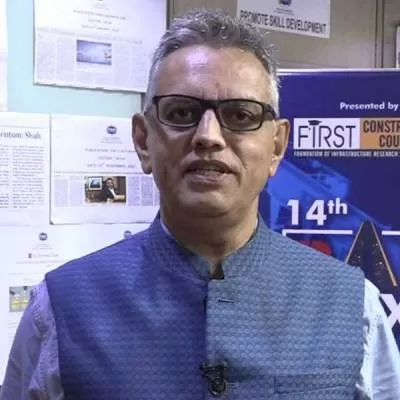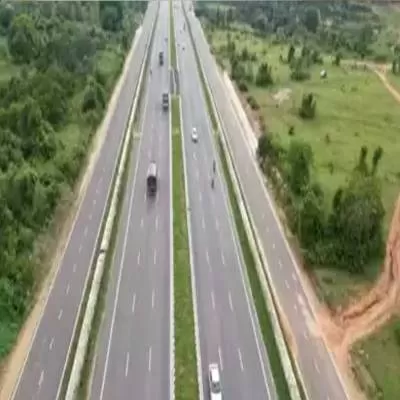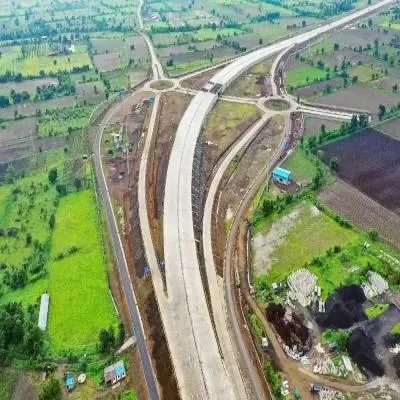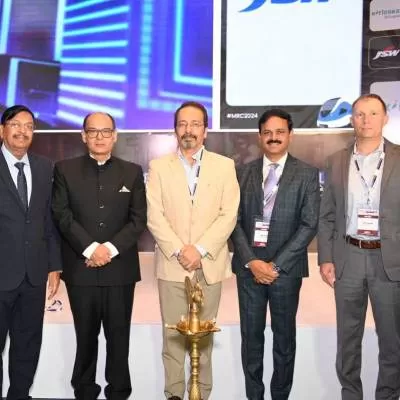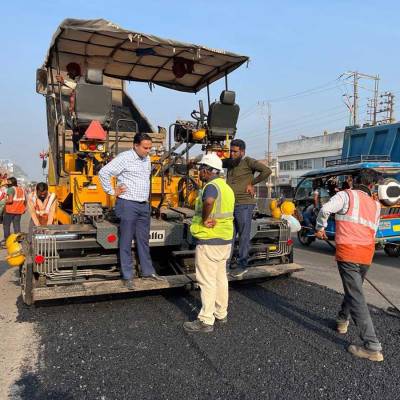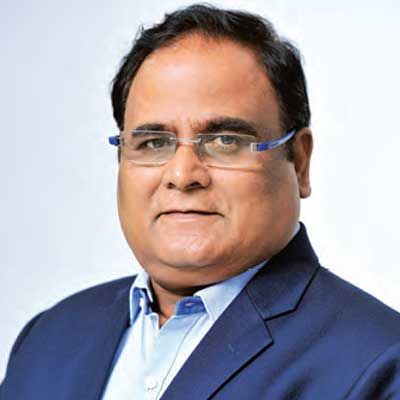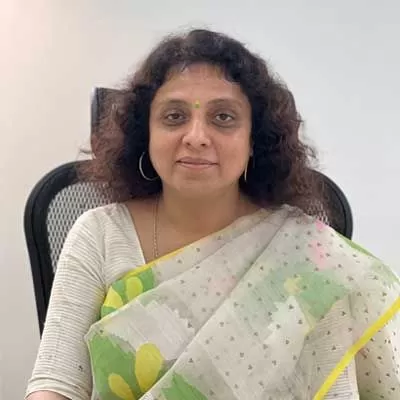- Home
- Infrastructure Transport
- ROADS & HIGHWAYS
- Life on the freeway
Life on the freeway
Mumbai presents us with ubiquitous images of the hustle and bustle of crowds, traffic snarls, congested roads and the ensuing cacophony. In such a scenario, the recent and quiet construction of the Eastern Freeway without the attendant chaos is worthy of commendation. The freeway is indeed an engineering marvel that comprises, amongst other things, an elevated roadway and an urban tunnel, which was inaugurated by Maharashtra Chief Minister Prithviraj Chauhan on June 13, 2013.
Conceptualised to ease traffic, the Eastern Freeway ensures speedy travel and a fairly comfortable ride from end to end. Seventeen kilometres long, it was constructed in three segments that connects Orange Gate on P D'Mello Road to Panjarpol, and near RK Studios in Chembur. This stretch of elevated road is the third longest in India, after the Kanpur Bypass Flyover on NH-2 and PV Narasimha Rao Expressway in Hyderabad. The remaining stretch from Panjarpol to the Ghatkopar-Mankhurd Link Road is expected to open by December 2013.
On the job
The major portion of the elevated road (9.2 km) was constructed by Simplex Infrastructure. The second part (5 km), which includes the 550-m-long tunnel, was constructed by Hyderabad-based Madhucon Projects. The third segment (2.5 km) of the freeway is being done by J Kumar Infraprojects. Built by MMRDA, it has been funded by the Central Government through JNNURM. A total cost of about Rs 1,250 crore has been invested in the project with over Rs 130 crore coming from JNNURM.
Construction mode
As the freeway was planned on the median of the existing road, carrying out heavy construction on site posed a challenge. It would entail halting and disruption of traffic in the area for long hours. Amitabh Mundra, Vice Chairman, Simplex Infrastructures, says, "The total length of the flyover comprises precast segmental and I girders, with post-tensioning structures erected with launching girders." Arvind D Dhabe, Deputy Engineer-Grade 1, MMRDA, adds, "If cast in situ was adopted instead of precast technology to erect the segments from the ground, it would have practically been impossible to block the traffic for three to four years." Although the use of precast technology amounts to an increase of 25 per cent in construction cost, it has benefited this project in terms of durability and faster construction. Here, Vivek Kumar, Deputy General Manager, J Kumar Infraprojects, avers, "Although the technology is commonly used, its extensive use in the urban context makes this project the first-of-its-kind in India."
There are two ways to launch these segments. As Dhabe informs us, "The first is through the under slunge method while the second is auto launching, which takes place above the piers, with the traffic moving below it. In this project, only the auto launch method has been used." The construction also involved an extensive amount and variety of building materials. Simplex Infrastructures, for instance, used 30.20 lakh bags of cement, reinforcement to the extent of 43,100 metric tonne (MT), 3,150 MT of high tensile steel and 800 MT of structural steel. Moreover, as Dhabe elaborates on the number of components used in the 9.2 km stretch, "A total of 355 spans, each comprising 13 segments and weighing 70-80 tonne, were used in the construction. Overall, a total of 3,346 segments were used in this stretch."
The roadblocks
There were various challenges that emerged while constructing the freeway, including land acquisition delays, resettlement and traffic issues. As it was built on Bombay Port Trust land, prior permission was needed from the government. Moreover, as the project was near the encroachments in the area, about 5,000 families had to be resettled.
Another peculiar challenge was faced during construction. "While on one hand, we had to erect segments at a height of 13 m across the existing 100-year-old VOB, on the other, we needed to erect segments at a height of 22 m to avoid clashes with the proposed metro line-II construction below," says Mundra. To counter this challenge, Dhabe reveals additional trusses were installed below the existing bridge so the segments could be transported to the site via that portion. "With heavy traffic plying under the freeway in the mornings, a huge chunk of the construction work had to be done in the night," informs Sharad Sabnis, Chief Engineer, MMRDA, speaking about the various hurdles surmounted during construction. Building the tunnel - a unique feature of the project - within city limits was also a huge challenge.
"Incorporating all the elements of civil engineering, a concrete road, tunnel and elevated road portions, was a major hurdle, which I believe we have achieved successfully," he adds.
Congestion solution
It has been two months now and the freeway has not only made the commute between the eastern suburbs and South Mumbai easier, but decongested major roads along its route.
As Sabnis tells us, "The project capacity is in the range of about 60,000 cars a day, and on the first day, there were about 25,000 vehicles recorded on the road. This has definitely met the project's planned expectations." However, SVR Srinivas, Additional Municipal Commissioner (E Subs), BMC, has a different view, "Although an iconic project, the traffic projections are less than expected. However, we look forward to positive results in the long run." The city would hope for the same.
Project details
Date of Completion: June 13, 2013.
Length: Total 17 km (constructed in three phases); First stretch: 9.2 km, second stretch: 5 km and third stretch: 2.5 km
Height: 22 m
Total cost: Rs 1,250 crore
Capacity: 60,000 cars per day
Built by: MMRDA (Mumbai Metropolitan Region Development Authority). Tel: 022-2659 0001/4000. Fax: 022-2659 1264. Website: www.mmrda.maharashtra.gov.in
Contractors: Simplex Infrastructures. Tel: 033 2301 1600. Website: www.simplexinfrastructures.com E-mail: simplexkolkata@simplexinfra.net; Mahucon Projects. Tel: 040-2355 6001-04. Website: www.madhucon.com E-mail: hyinfo@madhucon.com; J Kumar Infraprojects. Tel: 022-2673 0291/0848/6774 3555. E-mail: info@jkumar.com Website: www.jkumar.com
Tunnel talk
Concrete has been used to line the tunnel and the supporting structures - ISM beams - meet the project's stability requirement. The tunnel is also supported with light control features and ventilators have been installed as per required standards. The technique: Constructed by Madhucon Projects, drill and blast technology has been applied on the rock that lay in the middle of the planned project. N Seethaiah, Managing Director, Madhucon Projects, says, "The alignment of the tunnel part of the project passes through marshy lands, salt pans, heavy congested roads and thickly populated slums like Patel Nagar, Nagababa Nagar, etc. Moreover, shifting the highly inflammable utilities of ONGC, HPCL, Reliance and Naftolin supply lines - which fell in the same area - along with the 1,100 kva HT lines was difficult. But we surpassed the same successfully." Also, 36 religious structures were removed and reconstructed, while 5,600 tenements were relocated. Further, as the project alignment passed through various residential colonies, construction work was done in limited hours during the day.
Conducting the drill and blast on the rock was a real challenge as it was within city limits. Consortiums of technical experts had to ensure that safety measures were applied to control the vibrations and impact of the blasting, which was done through approved methodologies. "Although we wanted to use a tunnel boring machine, we had to adopt the conventional method because it was not possible to accommodate the tunnel boring machine in the given site," explains Seethaiah.
Delay factor: Although the project was contracted in 2005, it faced many delays owing to the issue of land acquisition. As a result, the company faced many monetary losses. Seethaiah confirms, "The contractor value of the project was Rs 250 crore.
However, owing to these delays, we have spent over 10 per cent extra than the payment received from the government."
To share your views on this project, write in at feedback@ASAPPmedia.com
Mumbai's recently constructed 17-km long Eastern Freeway ensures speedy travel and a fairly comfortable ride. Mumbai presents us with ubiquitous images of the hustle and bustle of crowds, traffic snarls, congested roads and the ensuing cacophony. In such a scenario, the recent and quiet construction of the Eastern Freeway without the attendant chaos is worthy of commendation. The freeway is indeed an engineering marvel that comprises, amongst other things, an elevated roadway and an urban tunnel, which was inaugurated by Maharashtra Chief Minister Prithviraj Chauhan on June 13, 2013. Conceptualised to ease traffic, the Eastern Freeway ensures speedy travel and a fairly comfortable ride from end to end. Seventeen kilometres long, it was constructed in three segments that connects Orange Gate on P D'Mello Road to Panjarpol, and near RK Studios in Chembur. This stretch of elevated road is the third longest in India, after the Kanpur Bypass Flyover on NH-2 and PV Narasimha Rao Expressway in Hyderabad. The remaining stretch from Panjarpol to the Ghatkopar-Mankhurd Link Road is expected to open by December 2013. On the job The major portion of the elevated road (9.2 km) was constructed by Simplex Infrastructure. The second part (5 km), which includes the 550-m-long tunnel, was constructed by Hyderabad-based Madhucon Projects. The third segment (2.5 km) of the freeway is being done by J Kumar Infraprojects. Built by MMRDA, it has been funded by the Central Government through JNNURM. A total cost of about Rs 1,250 crore has been invested in the project with over Rs 130 crore coming from JNNURM. Construction mode As the freeway was planned on the median of the existing road, carrying out heavy construction on site posed a challenge. It would entail halting and disruption of traffic in the area for long hours. Amitabh Mundra, Vice Chairman, Simplex Infrastructures, says, "The total length of the flyover comprises precast segmental and I girders, with post-tensioning structures erected with launching girders." Arvind D Dhabe, Deputy Engineer-Grade 1, MMRDA, adds, "If cast in situ was adopted instead of precast technology to erect the segments from the ground, it would have practically been impossible to block the traffic for three to four years." Although the use of precast technology amounts to an increase of 25 per cent in construction cost, it has benefited this project in terms of durability and faster construction. Here, Vivek Kumar, Deputy General Manager, J Kumar Infraprojects, avers, "Although the technology is commonly used, its extensive use in the urban context makes this project the first-of-its-kind in India." There are two ways to launch these segments. As Dhabe informs us, "The first is through the under slunge method while the second is auto launching, which takes place above the piers, with the traffic moving below it. In this project, only the auto launch method has been used." The construction also involved an extensive amount and variety of building materials. Simplex Infrastructures, for instance, used 30.20 lakh bags of cement, reinforcement to the extent of 43,100 metric tonne (MT), 3,150 MT of high tensile steel and 800 MT of structural steel. Moreover, as Dhabe elaborates on the number of components used in the 9.2 km stretch, "A total of 355 spans, each comprising 13 segments and weighing 70-80 tonne, were used in the construction. Overall, a total of 3,346 segments were used in this stretch." The roadblocks There were various challenges that emerged while constructing the freeway, including land acquisition delays, resettlement and traffic issues. As it was built on Bombay Port Trust land, prior permission was needed from the government. Moreover, as the project was near the encroachments in the area, about 5,000 families had to be resettled. Another peculiar challenge was faced during construction. "While on one hand, we had to erect segments at a height of 13 m across the existing 100-year-old VOB, on the other, we needed to erect segments at a height of 22 m to avoid clashes with the proposed metro line-II construction below," says Mundra. To counter this challenge, Dhabe reveals additional trusses were installed below the existing bridge so the segments could be transported to the site via that portion. "With heavy traffic plying under the freeway in the mornings, a huge chunk of the construction work had to be done in the night," informs Sharad Sabnis, Chief Engineer, MMRDA, speaking about the various hurdles surmounted during construction. Building the tunnel - a unique feature of the project - within city limits was also a huge challenge. "Incorporating all the elements of civil engineering, a concrete road, tunnel and elevated road portions, was a major hurdle, which I believe we have achieved successfully," he adds. Congestion solution It has been two months now and the freeway has not only made the commute between the eastern suburbs and South Mumbai easier, but decongested major roads along its route. As Sabnis tells us, "The project capacity is in the range of about 60,000 cars a day, and on the first day, there were about 25,000 vehicles recorded on the road. This has definitely met the project's planned expectations." However, SVR Srinivas, Additional Municipal Commissioner (E Subs), BMC, has a different view, "Although an iconic project, the traffic projections are less than expected. However, we look forward to positive results in the long run." The city would hope for the same. Project details Date of Completion: June 13, 2013. Length: Total 17 km (constructed in three phases); First stretch: 9.2 km, second stretch: 5 km and third stretch: 2.5 km Height: 22 m Total cost: Rs 1,250 crore Capacity: 60,000 cars per day Built by: MMRDA (Mumbai Metropolitan Region Development Authority). Tel: 022-2659 0001/4000. Fax: 022-2659 1264. Website: www.mmrda.maharashtra.gov.in Contractors: Simplex Infrastructures. Tel: 033 2301 1600. Website: www.simplexinfrastructures.com E-mail: simplexkolkata@simplexinfra.net; Mahucon Projects. Tel: 040-2355 6001-04. Website: www.madhucon.com E-mail: hyinfo@madhucon.com; J Kumar Infraprojects. Tel: 022-2673 0291/0848/6774 3555. E-mail: info@jkumar.com Website: www.jkumar.com Tunnel talk Concrete has been used to line the tunnel and the supporting structures - ISM beams - meet the project's stability requirement. The tunnel is also supported with light control features and ventilators have been installed as per required standards. The technique: Constructed by Madhucon Projects, drill and blast technology has been applied on the rock that lay in the middle of the planned project. N Seethaiah, Managing Director, Madhucon Projects, says, "The alignment of the tunnel part of the project passes through marshy lands, salt pans, heavy congested roads and thickly populated slums like Patel Nagar, Nagababa Nagar, etc. Moreover, shifting the highly inflammable utilities of ONGC, HPCL, Reliance and Naftolin supply lines - which fell in the same area - along with the 1,100 kva HT lines was difficult. But we surpassed the same successfully." Also, 36 religious structures were removed and reconstructed, while 5,600 tenements were relocated. Further, as the project alignment passed through various residential colonies, construction work was done in limited hours during the day. Conducting the drill and blast on the rock was a real challenge as it was within city limits. Consortiums of technical experts had to ensure that safety measures were applied to control the vibrations and impact of the blasting, which was done through approved methodologies. "Although we wanted to use a tunnel boring machine, we had to adopt the conventional method because it was not possible to accommodate the tunnel boring machine in the given site," explains Seethaiah. Delay factor: Although the project was contracted in 2005, it faced many delays owing to the issue of land acquisition. As a result, the company faced many monetary losses. Seethaiah confirms, "The contractor value of the project was Rs 250 crore. However, owing to these delays, we have spent over 10 per cent extra than the payment received from the government." To share your views on this project, write in at feedback@ASAPPmedia.com




